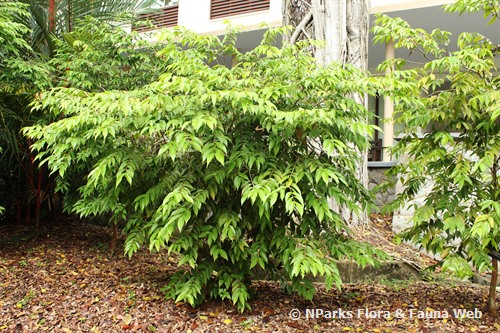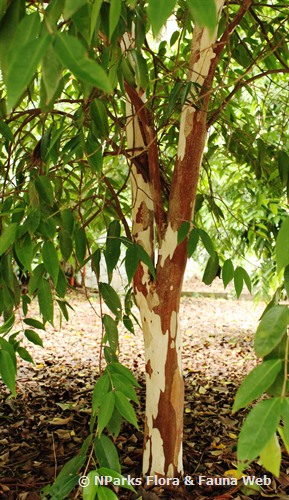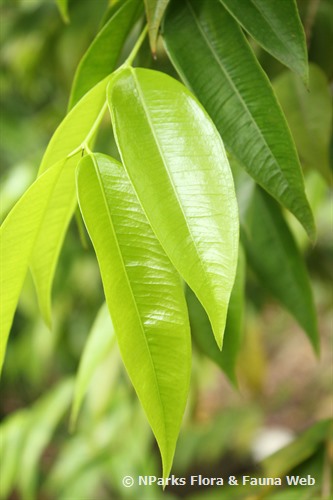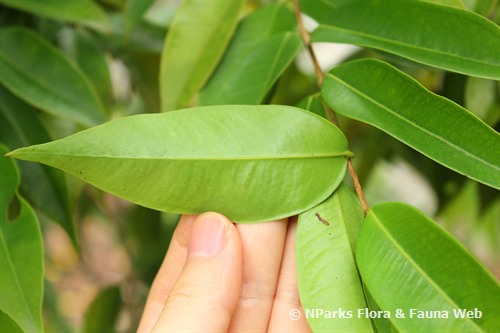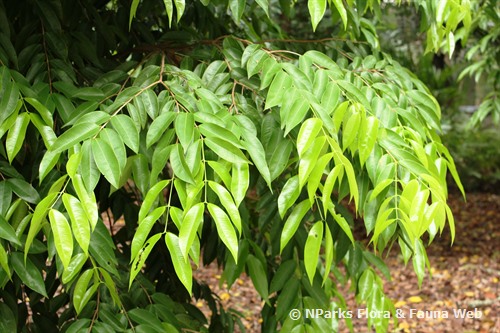
Name
Classifications and Characteristics
| Plant Division | Angiosperms (Flowering Seed Plants) (Dicotyledon) |
|---|---|
| Plant Growth Form | Tree (Shrubby (1m-5m)) |
| Lifespan (in Singapore) | Perennial |
| Mode of Nutrition | Autotrophic |
Biogeography
| Native Distribution | Costa Rica to Venezuela |
|---|---|
| Native Habitat | Terrestrial |
| Preferred Climate Zone | Tropical |
Description and Ethnobotany
| Growth Form | A small tree or shrub, usually grows around 2-5 m tall. |
|---|---|
| Trunk | The bark is reddish-brown and peeling, revealing the multicolored underbark. |
| Foliage | Leaves are arranged in opposite pairs, lanceolate to elliptic, measuring around 5-13 cm long and 2-5 cm wide. |
| Flowers | Flowers are white and small, borne in clusters. Each flower has numerous long stamens. |
| Fruit | Fruits are globular, measuring 2-3 cm in diameter. Unripe fruits are green and become purple to purplish-black when fully ripe. The fruit resembles a grape, but has a thick skin. Fruit pulp is whitish-translucent and edible, embedded with 1 to 2 seeds. |
| Cultivation | Plants do well in deep, rich, well-drained soils. Once mature, trees are able to produce large amount of fruit. |
| Etymology | Myrciaria is the Greek word for Myrtle, indicating this genus is a member of Myrtle family. |
| Ethnobotanical Uses | Edible Plant Parts : Edible Fruits Food (Fruit or Vegetable): Fruits are consumed raw or processed, used to make drinks and jellies. |
Landscaping Features
| Desirable Plant Features | Ornamental Fruits, Ornamental Form |
|---|---|
| Landscape Uses | Parks & Gardens |
| Thematic Landscaping | Economic Garden |
Fauna, Pollination and Dispersal
| Fauna Pollination Dispersal Associated Fauna | Bird-Attracting (Fruits) |
|---|---|
| Pollination Method(s) | Biotic (Fauna) |
Plant Care and Propagation
| Light Preference | Full Sun |
|---|---|
| Water Preference | Moderate Water |
| Plant Growth Rate | Moderate |
| Rootzone Tolerance | Moist Soils, Well-Drained Soils, Fertile Loamy Soils |
| Propagation Method | Seed |
Foliar
| Foliage Retention | Evergreen |
|---|---|
| Mature Foliage Colour(s) | Green |
| Foliar Type | Simple / Unifoliate |
| Foliar Arrangement Along Stem | Opposite |
Floral (Angiosperm)
| Flower Colour(s) | Cream / Off-White |
|---|---|
| Flower Grouping | Cluster / Inflorescence |
Fruit, Seed and Spore
| Mature Fruit Colour(s) | Black, Blue, Purple |
|---|---|
| Mature Fruit Texture(s) | Smooth |
| Seed Quantity Per Fruit | Few (1-5) |
Image Repository
Others
| Master ID | 32877 |
|---|---|
| Species ID | 7291 |
| Flora Disclaimer | The information in this website has been compiled from reliable sources, such as reference works on medicinal plants. It is not a substitute for medical advice or treatment and NParks does not purport to provide any medical advice. Readers should always consult his/her physician before using or consuming a plant for medicinal purposes. |

